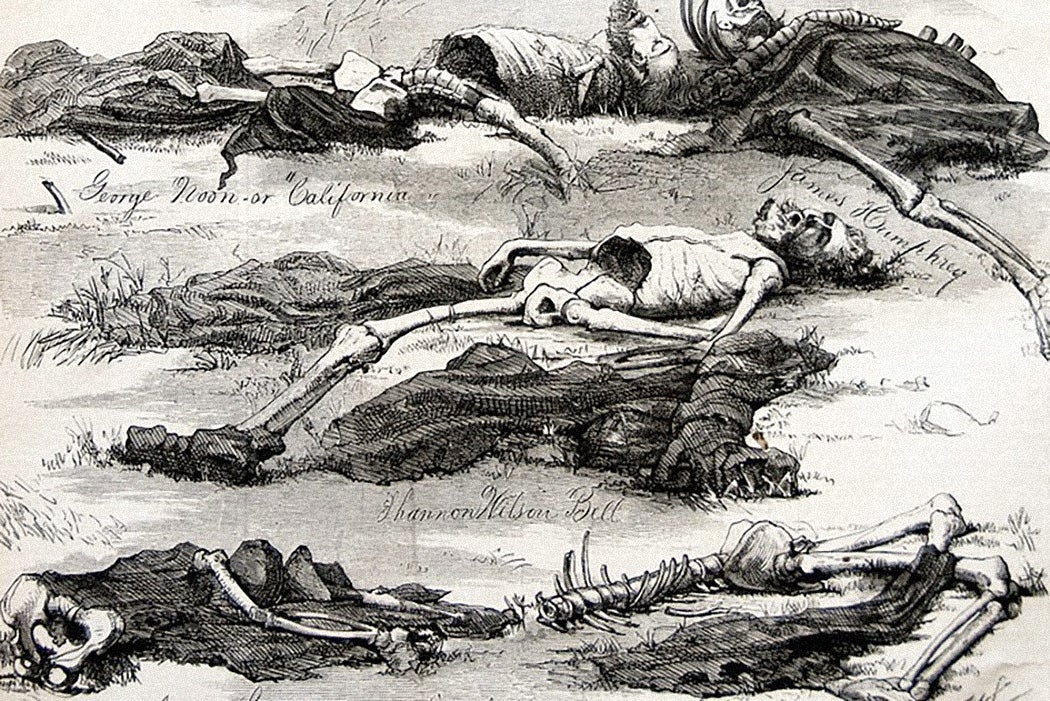The San Juan region in southwestern Colorado was known for its harsh winters. As historian Diana Di Stefano writes, winters “could last up to nine months [and] deep snowfall could make traveling practically impossible.” And in the late 1800s, those were particularly dangerous conditions. Because of the region’s gold and silver deposits, however, there were plenty who thought they were strong enough to endure the weather and were willing to take their chances if a fortune waited at the other end of their labors and risks.
But no matter how tough a miner may have been, the mountain was tougher, Di Stefano explains. The “freezing temperatures, sudden storms, and violent avalanches made traveling, living, and working in the mountains extremely dangerous.” So it wasn’t a huge surprise when, one April morning in 1874, a man emerged from the wilderness after a long winter and made an appearance at the Los Pinos Indian Agency near Gunnison. He was ragged, tired, and in need of a drink, which they happily provided.
His name was Alferd Packer, and he had a story to tell.
Alferd (some sources spelled his name “Alfred”) had been in the wilds for fifty-seven days. He’d been with five other miners at a winter camp on the other side of the mountain. The group had gotten lost in a vicious snowstorm, and Packer, with his frozen feet, snow blindness, and exhaustion, couldn’t keep up anymore. The group left him behind. He’d survived off of the land and his wits. But something was off in his story. Though Packer was tired and disheveled, “He seemed too well fed for a man who had spent the winter in the mountains,” Di Stefano writes. Plus, he’d paid for his drink with what journalist Andrew Curry describes as “a wad of cash.” Pretty odd for a man who had very little money when he’d set out on the trip.
The questions started forming. Where, exactly, were Packer’s companions? The truth unfolded over the next few weeks. Two of the men had died of starvation, Packer said, and were eaten by those who survived. The grim cycle continued until just Packer and one other man—Shannon Wilson Bell—remained. As Curry writes, Packer claimed he “shot Bell in self-defense, covering up the remains, and taking a large piece of Bell with him.” A search party set out to recover the bodies, but found nothing. When the winter landscape melted away, however, the bodies were uncovered. As a Harper’s Magazine article reported, “Marks of violence on each body indicated that a most terrible crime had been committed there.” An inquest later revealed that it seemed like each man was killed in his sleep. Packer was charged with murder and sent to jail to await trial. In the days that followed, more was revealed about him.
Packer had teamed up with a larger group of prospectors by convincing them he had knowledge of the treacherous mountains (he didn’t); that he could pay for his provisions (he couldn’t); and most importantly, that he was trustworthy (he wasn’t). By the time the men reached a winter camp along the Uncompahgre River in the middle of December, the group was done with him. Despite warnings to wait until spring, a breakaway group set off without Packer, and told him they’d shoot him if he tried to follow. Packer then left the camp with a smaller group, members of which would eventually be found dead.
Weekly Newsletter
When Packer was in jail for the crime, he maintained that he’d been forced to kill, Di Stefano explains. “He asserted that extreme conditions drove him to kill in order to save his own life and cannibalize his companions for survival.” But his story changed over time, each change making people more suspicious of his actual motives. Was Packer just a cold-blooded killer who conned and lured these men to their deaths? They’d have to wait ten years to find out, as Packer escaped from jail.
When he was finally caught and tried, he was sentenced to death. The sentence was later overturned, with 40 years of confinement imposed instead. He was paroled in 1901 after eighteen years behind bars. Packer’s story would be told for years to come as a horror story, but even more than that, Di Stefano argues, Packer represented a betrayal of the trust that miners had to have between one another. “His guilt lay not in cannibalism per se,” writes Di Stefano, “but his failure to act for the good of the group.”
Editor’s Note: This article has been amended to change “Sierra Nevada Mountains” to “San Juan Mountains.”







